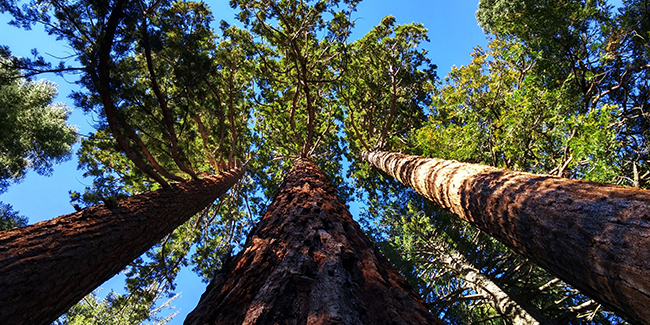The giant sequoia (Sequoiadendron giganteum), called the “Big Tree” in North America, is the tree of superlatives, as its name suggests. Indeed, everything in this conifer is out of the ordinary: first, a height that can reach more than 80 meters, like the “General Sherman” of Sequoia National Park in California which rises to 83m high and 11m in diameter at the base; its colossal diameter is more often between 5 and 8 meters. Finally, this conifer enjoys an incredible life expectancy with specimens that exceed 3000 years!

However, the Giant Sequoia is not the tallest tree in the world whose record goes to the Sequoia sempervirens with 115m, but it is indeed the most voluminous tree with 1400m3 esteemed for “General Sherman”!
Its habit is generally conical with dark, bushy foliage that lightens with age as the crown becomes rounded. The giant sequoia is a hardy conifer (-25°C) whose growth is quite rapid (50cm/year on average).
Its bark, very thick, reddish, fibrous, rough in contact with the skin, hides a very light wood, reddish also with fine grain, soft and durable.
Its foliage, quite lush, grayish green is persistent. The scaly, fleshy leaves are 6 to 12mm long and are arranged in a spiral around the twig.
The male and female cones, green the first year becoming reddish brown thereafter, are globose, ovoid, 5 to 8cm long, formed of around thirty thick nail-shaped scales, with a large wrinkled, depressed crest, which persist long after the seed has emerged.
Discovered by John Bidwell in California in 1841, the giant sequoia was sown in Great Britain by JD Matthews and William Lobb twelve years later. In American parks – Sequoia National Park and Yosemite National Park – giant sequoias are protected there.
- Family : Taxodiaceae
-
Kind : evergreen tree -
Origin : US Pacific coast (California, Nevada) - Color : greyish-green leaves, reddish bark
-
Sowing: Yes -
Cutting: Yes -
Planting: spring and autumn - Height : up to 85m
Ideal soil and exposure for planting a sequoia in the garden
The giant sequoia likes a well-opened, bright, sunny environment, benefiting from a certain summer heat, in a cool and deep soil, sheltered from the winds. The misty, humid climate of Great Britain suits it better than that of France because it absorbs water mainly through its aerial parts.
Date of sowing, cutting and planting of redwood
In spring, it is sown, in a pot, under a cold frame, but patience is required.
Herbaceous cuttings in spring or cuttings of semi-woody stems in summer can also be undertaken.
It is generally planted in the fall, but spring can also be considered.
Council of maintenance and culture of redwoods
The giant sequoia does not require any specific maintenance, as long as it is well installed. After planting, watering during the first dry summers may be necessary. It will also be necessary to ensure that it is not bothered by the wind which could put it down.

Diseases, pests and parasites of the redwood
The giant sequoia offers good resistance to attacks by fungi and insects.
Location and favorable association of redwood
The giant sequoia requires isolated planting to be highlighted, so it needs a large space. But the giant sequoia also makes an excellent alignment tree for a stately driveway.
Species and varieties of Sequoiadendron recommended for planting in the garden
Genre Sequoiadendron is monospecific, i.e. it has only one species: Sequoiadendron giganteum. Among its cultivars are Sequoiadendron giganteum ‘Glaucum’ with bluish foliage, Sequoiadendron giganteum ‘Pendulum’with a weeping habit, Sequoiadendron giganteum ‘Barabits Requiem’to the branches that bend along the trunk to rise at the ends.
